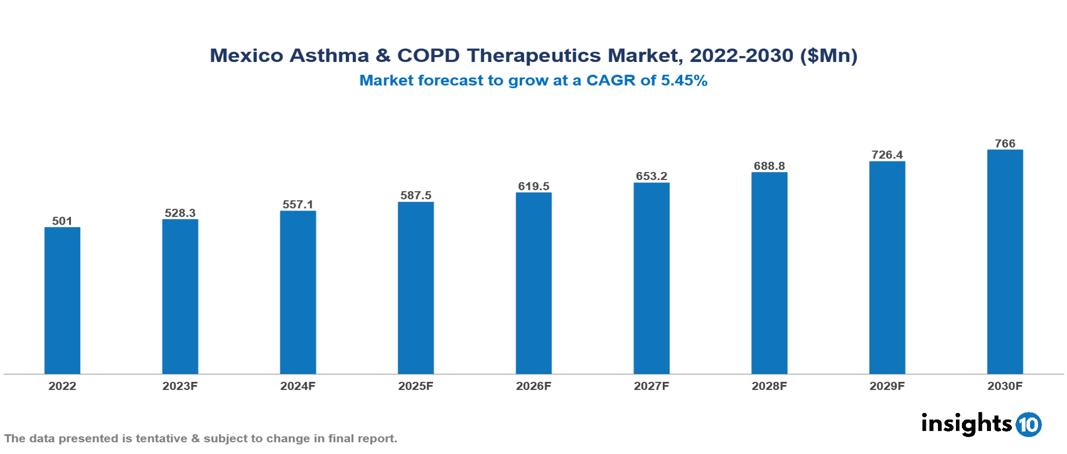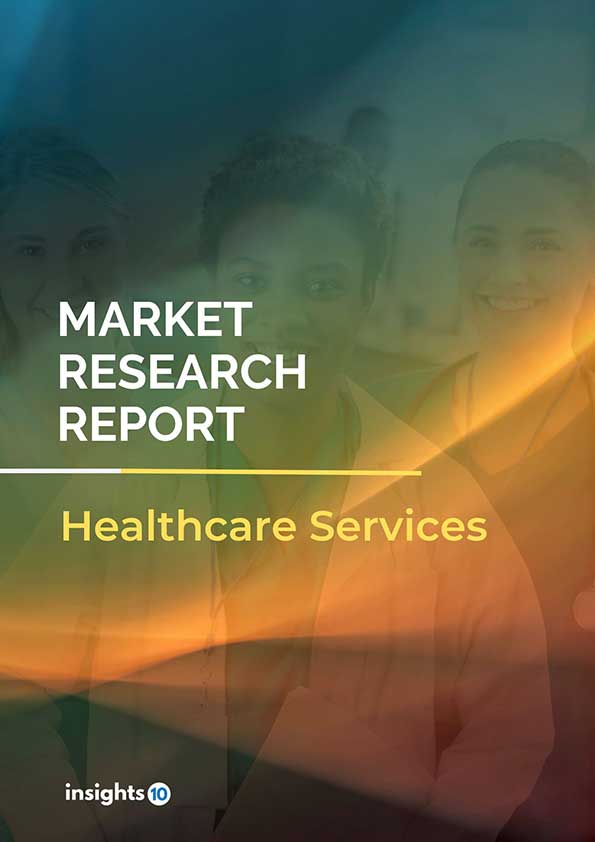Mexico Asthma and COPD Therapeutics Market Analysis
The Mexico Asthma and COPD Therapeutics Market was valued at US $501 Mn in 2022, and is predicted to grow at (CAGR) of 5.45% from 2023 to 2030, to US $766 Mn by 2030. The key drivers of this industry include the upward trend in the prevalence of COPD and asthma, increasing demand, supportive policies, and others. The industry is primarily dominated by players such as, GlaxoSmithKline, Tetherex, Novartis, AstraZeneca, Verona, and Boehringer Ingelheim, among others
Buy Now

Mexico Asthma and COPD Therapeutics Market Analysis: Executive Summary
The Mexico Asthma and COPD Therapeutics Market is at around US $501 Mn in 2022 and is projected to reach US $766 Mn in 2030, exhibiting a CAGR of 5.45% during the forecast period.
Asthma and Chronic Obstructive Pulmonary Disease (COPD) are persistent respiratory conditions that impact the airways, resulting in difficulties breathing. Asthma is characterized by inflammation and narrowing of the airways, often triggered by allergens, irritants, or physical activity. Common symptoms include wheezing, shortness of breath, chest tightness, and coughing, with risk factors such as a family history and respiratory infections. COPD encompasses chronic bronchitis and emphysema, leading to obstructed airways, with smoking identified as a primary risk factor. Observable COPD symptoms include a lingering cough, increased mucus production, and fatigue. Treatment for both asthma and COPD involves the use of bronchodilators to alleviate airway constriction and anti-inflammatory medications to address inflammation. Pharmaceuticals manufactured by companies like GlaxoSmithKline, AstraZeneca, and Boehringer Ingelheim are commonly prescribed for these conditions. Ongoing advancements in therapeutic approaches for asthma and COPD focus on innovative anti-inflammatory agents, bronchodilators, and targeted therapies.
COPD affects around 9% of the population, whereas the prevalence of asthma ranges from 6% to 8% across age groups 6–15 in Mexico. These estimates are closely linked to high rates of smoking, air pollution, and occupational exposures within the population. The primary factors driving the market are the increase in the aging population and the subsequent rise in asthma and COPD, demand for effective therapeutics, and supportive government policies. However, high costs of advanced treatment, limited access to healthcare, and limited public awareness are a few factors that limit the market's potential.
Market Dynamics
Market Growth Drivers
Surge in prevalence: The prevalence of COPD in Mexico is estimated to be approximately 9% in the age group 35 years and above. Subsequently, the prevalence of asthma is estimated to be around 6% in the age group 6-7 years and around 7.5% in children between 13 and 15 years. The contributing factors include elevated smoking rates, air pollution, and occupational exposures. The growing elderly population in Mexico is becoming more vulnerable to chronic respiratory conditions like COPD. The rising patient population leads to the growth of the market.
Growing demand for effective medications: Current medications for asthma and COPD frequently face limitations related to side effects, adherence, and long-term efficacy. This creates a need for new and more precisely targeted therapies. Advances in inhaler technology, biologics, and personalized medicine present encouraging possibilities for enhancing the management of these conditions.
Supportive government policies: The rise in government and private healthcare expenditures enables expanded access to advanced medications and treatment choices. Market growth is further fuelled by public health initiatives such as the Global Asthma Network Mexico, which targets increased awareness, enhanced diagnosis, and improved access to treatment.
Market Restraints
Cost of treatment: Inhalers, along with other delivery devices and newer biologic therapies, may pose a financial challenge for a considerable segment of the population, especially those lacking sufficient health insurance. This financial barrier can result in non-adherence to medication regimens and, subsequently, less favourable treatment outcomes.
Limited access to healthcare: The uneven distribution of healthcare facilities and staff, particularly in rural areas, establishes obstacles to access for numerous patients. Extended wait times and difficulties in transportation additionally hinder prompt diagnosis and treatment.
Lack of awareness: A lack of adequate knowledge about asthma and COPD, encompassing their symptoms and management approaches, among both patients and healthcare providers, can result in delays in diagnosis and appropriate treatment. Additionally, the stigma linked to respiratory conditions may discourage individuals from seeking assistance.
Healthcare Policies and Regulatory Landscape
Mexico's healthcare policy and regulatory landscape are directed by the Ministry of Health (Secretaría de Salud, or SSA), which serves as the central governing body responsible for crafting and executing health policies at the federal level. The SSA takes on a pivotal role in overseeing healthcare services, ensuring their quality, and addressing public health concerns. Additionally, individual states in Mexico, numbering 32 in total, maintain their own health departments, contributing to the broader healthcare framework while tailoring policies to suit regional requirements.
Securing a healthcare license in Mexico entails a multi-faceted process regulated by diverse authorities. Healthcare professionals, spanning physicians, nurses, and allied health practitioners, typically need to graduate from accredited institutions and successfully pass field-relevant examinations. Oversight related to pharmaceuticals and medical devices is conducted by the Federal Commission for the Protection against Sanitary Risk (Comisión Federal para la Protección contra Riesgos Sanitarios, or COFEPRIS). Licensing for healthcare professionals is often under the purview of specific councils or boards tied to each profession, such as the Mexican Council of General Medicine or the Mexican Nursing Council.
These regulatory entities ensure that healthcare practitioners meet the requisite standards and adhere to ethical and professional guidelines, contributing to the overall safety and quality of healthcare services in Mexico.
Competitive Landscape
Key Players
- GlaxoSmithKline
- AstraZeneca
- Boehringer Ingelheim Pharmaceuticals
- Novartis
- Pfizer
- Abbott Laboratories
- Merck
- Roche
- Tetherex Pharmaceuticals
- Verona Pharma
1. Executive Summary
1.1 Disease Overview
1.2 Global Scenario
1.3 Country Overview
1.4 Healthcare Scenario in Country
1.5 Patient Journey
1.6 Health Insurance Coverage in Country
1.7 Active Pharmaceutical Ingredient (API)
1.8 Recent Developments in the Country
2. Market Size and Forecasting
2.1 Epidemiology of Disease
2.2 Market Size (With Excel & Methodology)
2.3 Market Segmentation (Check all Segments in Segmentation Section)
3. Market Dynamics
3.1 Market Drivers
3.2 Market Restraints
4. Competitive Landscape
4.1 Major Market Share
4.2 Key Company Profile (Check all Companies in the Summary Section)
4.2.1 Company
4.2.1.1 Overview
4.2.1.2 Product Applications and Services
4.2.1.3 Recent Developments
4.2.1.4 Partnerships Ecosystem
4.2.1.5 Financials (Based on Availability)
5. Reimbursement Scenario
5.1 Reimbursement Regulation
5.2 Reimbursement Process for Diagnosis
5.3 Reimbursement Process for Treatment
6. Methodology and Scope
Mexico Asthma and COPD Therapeutics Market Segmentation
By Disease Type
- Asthma
- COPD
By Medication Class
- Combination drugs
- Short Acting Beta Agonists (SABA)
- Long Acting Beta Agonists (LABA)
- Leukotriene Antagonists (LTA)
- Anticholinergics
- Others
By Delivery Device
- Metered dose inhalers (MDI)
- Dry Powder inhalers (DPI)
- Nebulizers
By Route of Administration
- Inhaled
- Oral
- Others
By End User
- Asthma Patients
- COPD Patients
By Distribution Channel
- Retail Pharmacies
- Hospital Pharmacies
- Online Pharmacies
Methodology for Database Creation
Our database offers a comprehensive list of healthcare centers, meticulously curated to provide detailed information on a wide range of specialties and services. It includes top-tier hospitals, clinics, and diagnostic facilities across 30 countries and 24 specialties, ensuring users can find the healthcare services they need.
Additionally, we provide a comprehensive list of Key Opinion Leaders (KOLs) based on your requirements. Our curated list captures various crucial aspects of the KOLs, offering more than just general information. Whether you're looking to boost brand awareness, drive engagement, or launch a new product, our extensive list of KOLs ensures you have the right experts by your side. Covering 30 countries and 36 specialties, our database guarantees access to the best KOLs in the healthcare industry, supporting strategic decisions and enhancing your initiatives.
How Do We Get It?
Our database is created and maintained through a combination of secondary and primary research methodologies.
1. Secondary Research
With many years of experience in the healthcare field, we have our own rich proprietary data from various past projects. This historical data serves as the foundation for our database. Our continuous process of gathering data involves:
- Analyzing historical proprietary data collected from multiple projects.
- Regularly updating our existing data sets with new findings and trends.
- Ensuring data consistency and accuracy through rigorous validation processes.
With extensive experience in the field, we have developed a proprietary GenAI-based technology that is uniquely tailored to our organization. This advanced technology enables us to scan a wide array of relevant information sources across the internet. Our data-gathering process includes:
- Searching through academic conferences, published research, citations, and social media platforms
- Collecting and compiling diverse data to build a comprehensive and detailed database
- Continuously updating our database with new information to ensure its relevance and accuracy
2. Primary Research
To complement and validate our secondary data, we engage in primary research through local tie-ups and partnerships. This process involves:
- Collaborating with local healthcare providers, hospitals, and clinics to gather real-time data.
- Conducting surveys, interviews, and field studies to collect fresh data directly from the source.
- Continuously refreshing our database to ensure that the information remains current and reliable.
- Validating secondary data through cross-referencing with primary data to ensure accuracy and relevance.
Combining Secondary and Primary Research
By integrating both secondary and primary research methodologies, we ensure that our database is comprehensive, accurate, and up-to-date. The combined process involves:
- Merging historical data from secondary research with real-time data from primary research.
- Conducting thorough data validation and cleansing to remove inconsistencies and errors.
- Organizing data into a structured format that is easily accessible and usable for various applications.
- Continuously monitoring and updating the database to reflect the latest developments and trends in the healthcare field.
Through this meticulous process, we create a final database tailored to each region and domain within the healthcare industry. This approach ensures that our clients receive reliable and relevant data, empowering them to make informed decisions and drive innovation in their respective fields.
To request a free sample copy of this report, please complete the form below.
We value your inquiry and offer free customization with every report to fulfil your exact research needs.









































